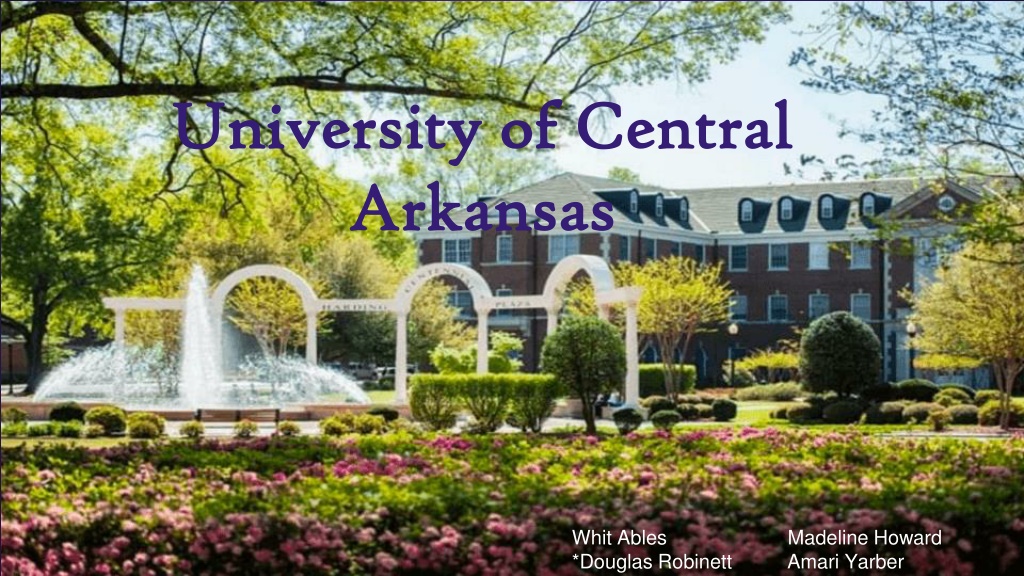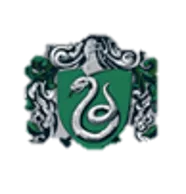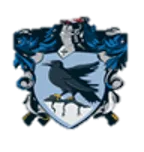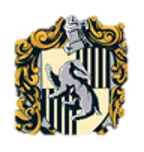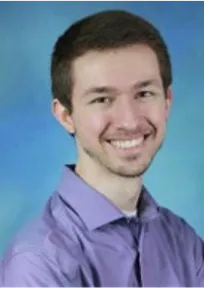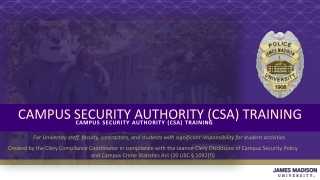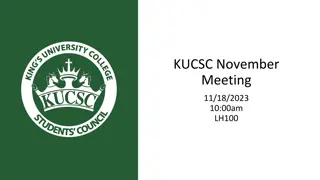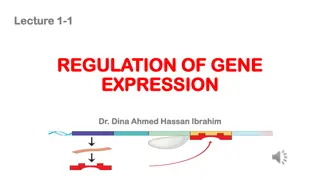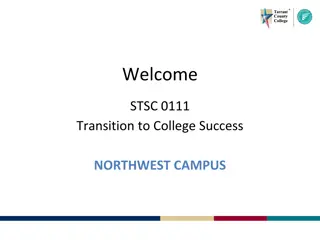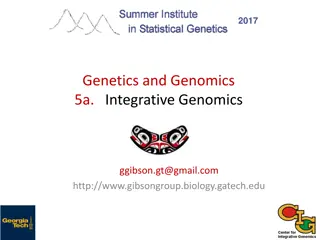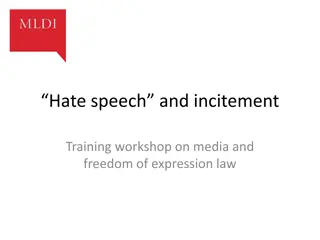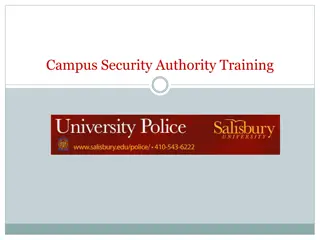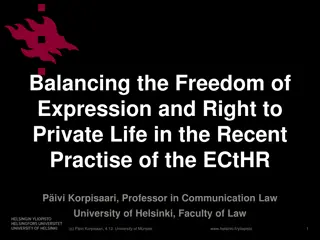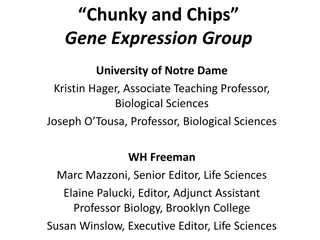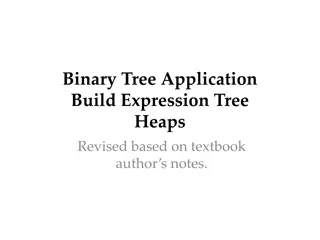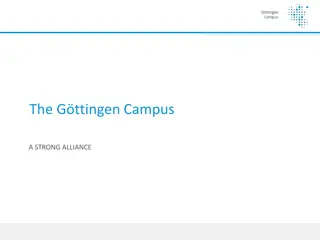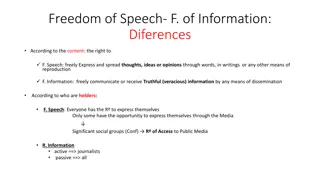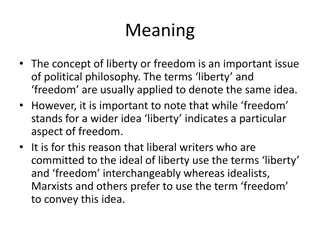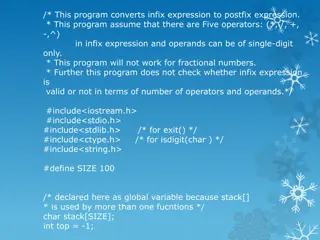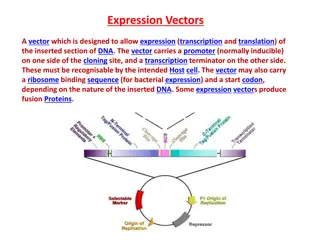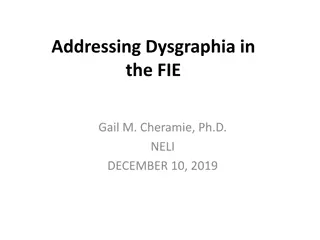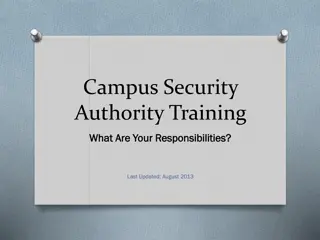Freedom of Expression and Campus Policies
Delve into the dynamics of freedom of expression, civil discourse, and counter discourse within higher education institutions. Analyze the current policies on outside speakers, proposed changes, and the impact on student bodies. Gain insights into theories of moral development shaping student behavior and campus culture.
Download Presentation

Please find below an Image/Link to download the presentation.
The content on the website is provided AS IS for your information and personal use only. It may not be sold, licensed, or shared on other websites without obtaining consent from the author.If you encounter any issues during the download, it is possible that the publisher has removed the file from their server.
You are allowed to download the files provided on this website for personal or commercial use, subject to the condition that they are used lawfully. All files are the property of their respective owners.
The content on the website is provided AS IS for your information and personal use only. It may not be sold, licensed, or shared on other websites without obtaining consent from the author.
E N D
Presentation Transcript
University of Central University of Central Arkansas Arkansas Whit Ables *Douglas Robinett Amari Yarber Madeline Howard
Meet the Muggles of UCA Team Leader Douglas Robinett 1st Year CSPA Graduate Student with an assistantship in Housing and ResLife Madeline Howard 1st Year CSPA Graduate Student with an assistantship in Housing and ResLife Amari Yarber 1st Year CSPA Graduate Student with an assistantship in The Leadership Studies Department Whit Ables 1st Year CSPA Graduate Student with an assistantship in Transfer Services and Academic Advising
Outline Learning Outcomes Defining freedom of expression, civil discourse, and counter discourse Current hierarchy of registered student organizations and current policies on outside speakers Proposed changes in policy: strengths, limitations, and outcomes of change The importance of the student body s utilization of freedom of expression at higher education institutions Moving forward: the future of higher education and freedom of expression Student affairs professionals will be able to: recall the definitions of freedom of speech, civil discourse, and counter culture compare freedom of speech and civil discourse and how they have evolved with the emergence of counter culture evaluate their campus culture and assess the ways in which the campus could improve the oversight of their student organizations value differing perspectives of their student population and organize events to promote these perspectives critique their current policies regarding RSO s and guest speakers
Theories Kohlberg s Theory of Moral Development (1981)- Students that participated in the outburst on the campus were in the individualistic and instrumental morality stage (Florida State University, 2011)1 Rest s Neo Kohlbergian Approach (2000)- Students focus on their personal interests more so than looking at the bigger picture of campus/social norms (Florida State University, 2011) Sanford s Theory of Challenge and Support (1966)- For growth to occur, students need an appropriate amount of support for the needs of the task. The growth of the student is heavily influenced by the campus environment (both inside the classroom and out (Boehman, 2010)2 Perry s Theory of Moral Development (1960 s)- Students initially come to a higher educational institution with a dualistic ideology, absolute right and absolute wrong; the hope is that by the end of their four years, students see the world through a pluralistic- commitment- point of view (Boehman, 2010) 3
People demand freedom of speech as a compensation for the freedom of thought which they seldom use. -S ren Kierkegaard (19th Century Danish Philosopher) You can't have a university without having free speech, even though at times it makes us terribly uncomfortable. If students are not going to hear controversial ideas on college campuses, they're not going to hear them in America. I believe it's part of their education, -Donna Shalala (2008 Medal of Freedom recipient)
First Amendment Overview First Amendment to the Constitution guarantees the freedom of expression without penalty Freedom of expression includes the following: freedom of assembly, freedom of religion, freedom of speech, freedom of the press Freedom of speech is an individual's right to voice their own ideas, beliefs, or thoughts without penalty or punishment by the law CAUTION - FREEDOM OF SPEECH DOES NOT PROTECT ALL SPEECH*
Protected Freedom of Speech Not Protected Encouraging actions that would harm others Making or distributing obscene materials (ex. child pornography) Burning draft cards as a form of anti-war protest Permitting students to print articles in the school newspaper over objections of the school administration (libel) Students making an obscene speech at a school-sponsored event (slander) Students advocating illegal drug use at a school-sponsored event The choice to not speak (specifically, the right not to salute the flag) Allowing students to wear black armbands to school to protest war The use of certain offensive words and phrases to convey political messages Contributing money (under certain circumstances) to political campaigns Advertising commercial products and professional services (with restrictions) Engaging in symbolic speech, (ex. burning the flag in protest)
Freedom of Speech Throughout History Political Movements Students for a Democratic Society (SDS) Young Americans for Freedom The Student Nonviolent Coordinating Committee The Southern Christian Leadership Conference (SCLC) Civil Rights Movements Freedom Riders The Congress on Racial Equality (CORE) Free Speech Movement - 1964 Feminist Movement LGBTQ Movement
What is Civil Discourse What is Not Civil Discourse Civil discourse is not longing civil when one of the participating parties: Personally threatens the other party Takes away the rights and/or safety from the other party Demonstrates prejudice hatred toward a specific person or group of people The goal of civil discourse is education and understanding This is not possible when one or more parties are dismissive (or worse) toward the ideas and perspectives of others This type of discourse is NOT protected by freedom of speech Discourse with the intention of encouraging learning and understanding Programs implement civil discourse adapted by higher education institutions (Linvell & Pyle, 2017) To be properly prepared for the world they will be entering, students must explore and be armed to engage in meaningful civil discourse (p.2) Social media creates new opportunities and risks for civil discourse (Junco & Chickering, 2010) Student affairs professionals can hold programs to help students use civil discourse in social media to avoid or mediate online disputes If we are going to have a functioning and healthy democratic society, we need to be open to civil discourse. In other words, we have to be able to disagree without being disagreeable - Glenn Antizzo
One Step Further: Counter Discourse Counter-discourse: conversation, debate, or manner of thinking that goes against an institutionalized beliefs, norms, or discourses Promotes thinking outside of institutionalized norms and helps give a voice to marginalized or underrepresented cultures and populations Protected by freedom of speech Examples: Institution administrators need to use counter-discourse to address challenges with assessment (Boud, 2007) Counter-discourse is utilized in higher education institutions to increase diversity in the workforce and in the student population (Alexander, Cleland, & Nicholson, 2017)
Registered Student Organizations (RSOs) Organizations that are recognized by the institution for being important to civic, educational, social, and/or professional development in the student population Can use campus facilities Host activities and non-profit events sponsored by the institution Can request funding from the institution RSO s can also invite outside speakers to their meetings and events However, sometimes these speakers can either be harmful, causing issues with the organization, the student body, and even with the campus Office of Student Involvement and campus administration Issues created by outside speakers have a long-reaching effect on almost everybody involved and sometimes demand changes in policies* Example: Texas A&M had policy changes to require outside speakers to be sponsored by an RSO (CNN, 2017)
Slyvendorepuff University Mission The mission of Slyvendorepuff University is to cultivate well-rounded and educated students by providing leadership opportunities that continue to thrive in a richly diverse and globally aware community. 4-year public institution The campus is composed of 10,000 students The population is 85% Caucasian, 10% African American, 4% other, and 1% international We are a non-religious affiliated institution Located in Narnia The institution prides itself on its scenery and natural aesthetics*
Hierarchy at Slyvendorepuff University President VP of Student Affairs* (Albus Longbottom) Dean of Students (Ronald Granger) Office of Student Affairs Office of Student Involvement Outside Speakers Student Government Association RSO- The Society That Shall Not Be Named
Current Policies All RSO s are welcomed to be created on this campus 1 RSO s bringing in guest speakers have to: Go through SGA for funding Reserve their own space through the OSI website Communicate with Physical Plant to set-up tables/chairs 2 Make their own flyers to pass out around campus Approved by the office of Housing and Residence Life to post in the residential halls Having a neutral location Ballroom, tiered classroom, theater, or auditorium
The Good, the Bad, and the Counter-Discourse Due to technology becoming so dominant in today's culture, the RSO hosting the event no longer bares the negative publicity, it's the entire institutions reputation The President of the United States has been getting involved with protests happening on higher educational campuses (Janshik & Lederman, 2017) RSO s are one avenue on the institutions campus that produces strong leaders and an autonomous voice for students, especially minority students, to be active within their collegial community (Stanford University, n.d.)
Updated Hierarchy at Slyvendorepuff University President VP of Student Affairs* (Albus Longbottom) VP of Academic Affairs Dean of Students (Ronald Granger) Dean of Academic Affairs Office of Student Affairs Office of Student Involvement Department of Defense against the Dark Arts Outside Speakers Student Government Association RSO- The Society That Shall Not Be Named Faculty Member (Professor Snape)
New Policy RSO s bringing in guest speakers have to: Have a faculty/staff advisor knowledgeable of the subject1 Go through SGA for funding Send OSI an email to reserve a space and provide information about event 2 Communicate with Physical Plant to set-up tables/chairs Make their own flyers to pass out around campus Approved by the office of Housing and Residence Life to post in the residential halls
Freedom of Speech Today and Higher Education Without the free flow of information from all demographics on a higher educational institution, there would never be improvements within society We have seen now-protected groups get expelled and attacked on campuses due to their identities and ideologies Higher education institutions must continue to do better for their students such as listening to their needs and wants so there is not a repeat of history Freedom of speech is at the crossroads of ethics and law, which means that even if something is ethically right, it doesn t mean that it s always protected by the law Policies should never remain static Contrarily, policies should be dynamic and allow for constant maintenance to accommodate for the ever-changing environment on higher educational campuses
References Alexander, K., Cleland, J., & Nicholson, S. (2017). Let us not neglect the impact of organizational culture on increasing diversity within medical schools. Perspectives on medical education, 6(2), 65-67. Boehman, J. (2010). Student Development Theories. Retrieved February 13, 2018, from https://facultystaff.richmond.edu/~jboehman/sdt.pdf Boud, D. (2007). Reframing assessment as if learning were important. Rethinking assessment in higher education: Learning for the longer term, 14-25. Florida State University. (2011, April 10). Moral Development. Retrieved February 13, 2018, from https://studentdevelopmenttheory.wordpress.com/morality/ Foundation for Individual Rights in Education. (n.d.). Private Universities. Retrieved February 16, 2018, from https://www.thefire.org/spotlight/public-and-private-universities/ Jaschik, S., & Lederman, D. (2017, February 2). Amid Violence, Yiannopoulos Speech at Berkeley Canceled. Retrieved February 12, 2018, from https://www.insidehighered.com/news/2017/02/02/violent-protests-visiting-mob-lead-berkeley-cancel-speech-milo-yiannopoulos Junco, R., & Chickering, A. W. (2010). Civil discourse in the age of social media. About Campus, 15(4), 12-18. Linvill, D. L., & Pyle, A. S. (2017). Inquiry-based civil discourse education. Communication Teacher, 31(4), 214-219. Oklahoma State University. (n.d.). Healy v. James, 408 U.S. 169 (1972). Retrieved February 10, 2018, from http://media.okstate.edu/faculty/jsenat/jb3163/healy.html Stanford University. (n.d.). Local Autonomy. Retrieved February 12, 2018, from https://sal.stanford.edu/other/critical-university-policies/local- autonomy What Does Free Speech Mean? (n.d.). Retrieved February 16, 2018, from http://www.uscourts.gov/about-federal-courts/educational- resources/about-educational-outreach/activity-resources/what-does
